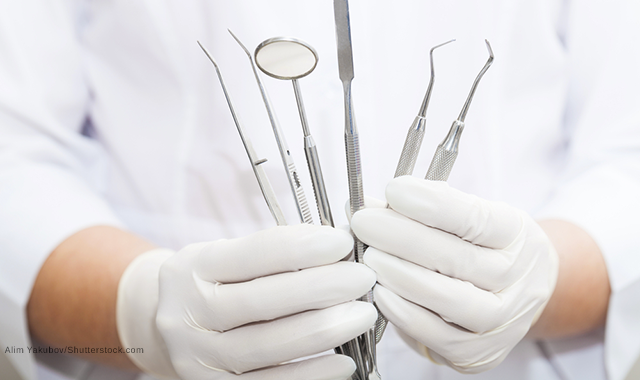- Best Practices New Normal
- Digital Dentistry
- Data Security
- Implants
- Catapult Education
- COVID-19
- Digital Imaging
- Laser Dentistry
- Restorative Dentistry
- Cosmetic Dentistry
- Periodontics
- Oral Care
- Evaluating Dental Materials
- Cement and Adhesives
- Equipment & Supplies
- Ergonomics
- Products
- Dentures
- Infection Control
- Orthodontics
- Technology
- Techniques
- Materials
- Emerging Research
- Pediatric Dentistry
- Endodontics
- Oral-Systemic Health
5 important facts about new code D4346 for a fresh start in 2017
Here are five important facts you need to know about the new code.

With 2017 almost here, it’s possible we need to buy a new outfit to wear for New Year’s. Or at least a new pair of shoes may be necessary. You found a great sale on exactly what you hoped to find, but when you get home, you find there isn’t much room in your closet to fit the new items.
Just as our clothes closets get cluttered over time with garments we no longer wear, our hygiene closets also get cluttered with products and protocols we no longer use.
For example, 2017 brings a new code for the therapeutic treatment of gingival inflammation many of us have been wanting for a long time. It can be a great fit into our current protocols.
However, the challenge is freeing up space in our hygiene closet. Just like at home with our New Year’s clothes and shoes, sometimes it’s time to clean out the closet. What a great time to get a fresh start on a new year – out with the old, in with the new!
Related reading: A game changer: 2017 will bring a new CDT code for gingivitis
Just the facts
To understand how this code fits in the closet, we need to read and dissect the code that reads: D4346 scaling in presence of generalized moderate or severe gingival inflammation – full mouth, after oral evaluation.*
There are five important facts that need a deeper understanding:
Therapeutic: D4346 is not preventive, it is for therapeutic care and appears in the perio section of CDT.
Full mouth: This new code is not a partial-mouth code. The description specifically states it is not performed in conjunction with full-mouth debridement, prophylaxis or scaling and root planing procedures.
After oral evaluation:D4346 requires an evaluation before it can be performed.
Not age based: Different from the prophylaxis codes, D4346 has no age requirements or limitations.
In the absence of periodontitis: The description of the new code contains the words, “in the absence of periodontitis. The diagnosis of periodontitis is based on clinical attachment loss therefore a perio chart and radiographic images are needed to make this diagnosis
More details and application cases are available in the book A Gingivitis Code Finally!)
More from the author: 6 CDT changes shaping dentistry
Calling a wound a wound
While all the stuff is out of the closet and being reorganized for 2017, it’s a terrific opportunity to bring something different into our care plans. We will easily have space in the closet when we get rid of a lot of tradition-based, non-scientific based clutter – the shoulder-padded blazers of hygiene if you will.
Periodontitis and gingival disease should be considered wounds as this quote from Roy C. Page, DDS, PhD Professor Emeritus, Periodontics University of Washington says:
“The amount of gingival surface area involved in the disease is about the same surface area as the palm of the hand. If you went into a hospital ER with the palm of your hand bleeding and swollen, you would be admitted on the spot.”
Wounds need something more than our traditional care only. It’s time to reconsider our chemical therapeutic modalities designed to kill and destroy.
When the pathogens for dental caries, gingivitis and periodontitis attack oral tissues, white blood cells and other defenders rush in to fight a battle of infection and inflammation.
During the fight, unstable molecules steal electrons from cell structures, leading to tissue damage. Antioxidants donate electrons to neutralize free radicals. When there aren’t enough antioxidants, the free radicals and reactive oxygen species (ROS) accumulate, resulting in oxidative stress.
A simple therapeutic step
The use of antioxidants for the treatment of disease dates to ancient times when herbs and spices were used. Natural antioxidants are recognized and utilized by the body to reduce oxidative stress and restore health. Today antioxidants are used in a wide variety of clinical applications.
Administering local therapeutic antioxidants to the oral cavity during procedures and instructing patients to continue the daily use of natural therapeutic antioxidants in the form of rinses and gels can reverse chronic inflammation. (To learn more, http://triologycare.com/)
There are appropriate codes for these steps. A code familiar to many was revised for CDT 2017. D9620 now reads “drugs or medicaments dispensed in the office for home use.” D1330 oral hygiene instructions is the most accurate code for daily use instructions.
This simple step can be easily added to the hygiene closet and our therapeutic treatment plans for our cases. Take the leap, clean the hygiene closet and get a fresh start on 2017.
* License to use ADA CDT codes granted to Patti DiGangi. Current Dental Terminology© 2017 & Systematized Nomenclature of Dentistry© 2017 American Dental Association. All rights reserved
Product Bites – January 12, 2024
January 12th 2024The weekly new products podcast from Dental Products Report is back. With a quick look at all of the newest dental product launches, Product Bites makes sure you don't miss the next innovation for your practice. This week's Product Bites podcast features new launches from Videa Health and DentalXChange.
Product Bites – October 27, 2023
October 27th 2023Product Bites makes sure you don't miss the next innovation for your practice. This week's Product Bites podcast features new launches from Kerr Dental, MGF, PreXion, ZimVie, Amann Girrbach, VOCO, ASI Dental Specialties, DMG, and NovoDynamics. [8 Minutes]
